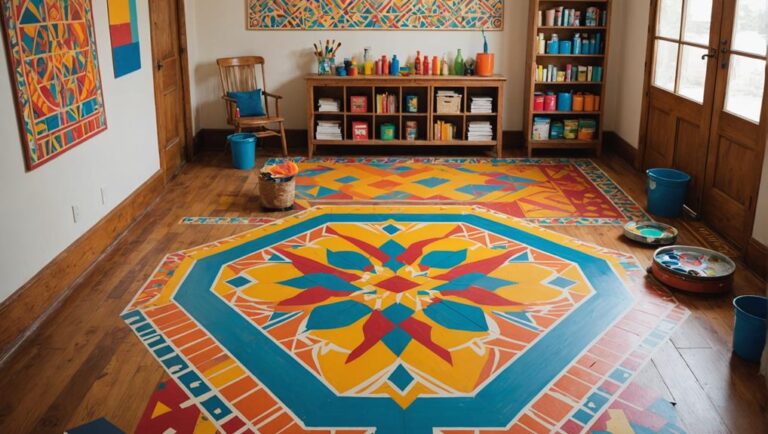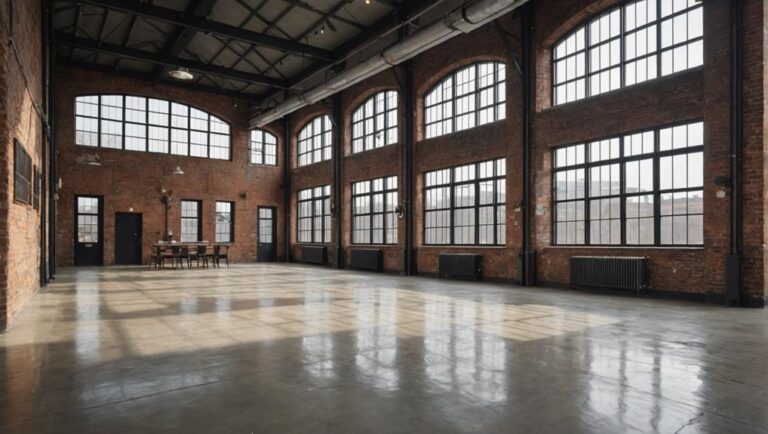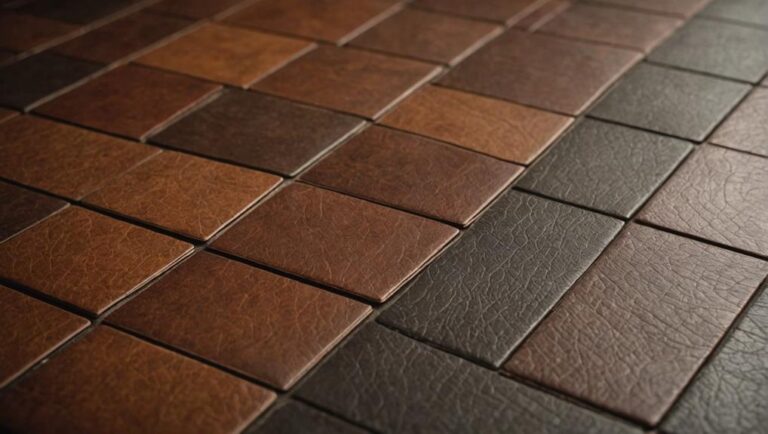When choosing floor finishes for commercial kitchens, prioritize safety and durability. Look for slip-resistant options to minimize accidents in wet or greasy conditions, like rubber flooring or epoxy resin. Ascertain the material can withstand heavy foot traffic and frequent cleaning, promoting hygiene and reducing long-term maintenance costs. Also, consider aesthetics that can enhance the kitchen's appearance while choosing finishes that comply with health codes. Regular maintenance is essential to prolong the life of your flooring and prevent safety hazards. By focusing on these factors, you'll create a safer kitchen environment that supports your operational needs. You'll discover more insights by exploring further.
Importance of Floor Finishes
When it comes to commercial kitchens, the choice of floor finishes isn't just an aesthetic decision—it's a critical safety measure. The right flooring can greatly reduce the risk of slips and falls, which are among the most common accidents in food service environments. With the presence of water, grease, and food debris, it is crucial to select a floor finish that offers both slip resistance and ease of cleaning.
Moreover, you'll want to reflect on the environmental impact of your flooring choice. Sustainable materials, such as recycled rubber or bamboo, not only contribute to a greener kitchen but can also enhance safety by providing effective traction. Floors that are easy to maintain will reduce the likelihood of harmful bacteria buildup, ensuring a safer space for food preparation.
While aesthetic appeal might be a secondary thought in a kitchen setting, it shouldn't be entirely overlooked. A well-designed floor can improve the overall atmosphere of the kitchen, making it more inviting for staff. However, aesthetics should never compromise safety.
You should always prioritize materials that comply with industry safety standards, ensuring they are durable enough to withstand heavy foot traffic and equipment movement. In the long run, investing in quality floor finishes will not only enhance safety but also reduce maintenance costs and improve the kitchen's operational efficiency. Remember, the right choice can create a safer, more productive environment while also supporting your commitment to sustainability.
Key Considerations for Selection
Selecting the right floor finish for your commercial kitchen involves several critical considerations that can considerably impact safety and functionality. First and foremost, you should prioritize slip resistance. Kitchens are often wet and greasy environments, so a finish with a high coefficient of friction can help prevent slips and falls, minimizing injury risks for your staff.
Durability is another key factor. The floor finish must withstand heavy foot traffic, impacts from equipment, and frequent cleaning. Look for materials that are not only tough but also resistant to stains and chemicals, as spills are inevitable in a kitchen setting.
Next, consider maintenance requirements. A low-maintenance finish can save you time and money, allowing your staff to focus on food preparation rather than floor upkeep. Easy cleaning solutions are essential in maintaining hygiene standards.
While safety and functionality are paramount, don't overlook color selection and aesthetic appeal. The right color can enhance the kitchen's overall appearance, creating a more inviting atmosphere. Lighter colors can make spaces feel larger and brighter, while darker shades may help conceal dirt and stains. However, make certain that your color choice aligns with safety standards—contrasting colors can help delineate work zones and pathways, improving visibility and reducing accidents.
Ultimately, a thorough approach that balances safety, durability, maintenance, and aesthetic considerations will lead you to the best floor finish for your commercial kitchen.
Types of Floor Finishes
Choosing the right type of floor finish for your commercial kitchen is essential for maintaining safety and efficiency. Different flooring options come with unique benefits and considerations, so you'll want to choose one that meets your kitchen's specific needs.
Epoxy coatings are a popular choice due to their durability and ease of maintenance. They create a seamless, non-porous surface that's resistant to spills and stains, making it a safe option for busy kitchens. Vinyl tiles offer flexibility in design and are slip-resistant, which helps minimize accidents.
Polished concrete is another strong contender; it provides a low-maintenance finish that can withstand heavy foot traffic. If you're looking for cushioning underfoot, rubber flooring is ideal, as it reduces fatigue and improves safety in areas prone to slips.
Ceramic tiles and linoleum sheets are excellent options for moisture-prone areas, providing a water-resistant surface. Hardwood alternatives, such as bamboo options, can offer aesthetic appeal while being eco-friendly. However, they may require more maintenance to keep them safe and functional.
For a unique finish, consider terrazzo finishes, known for their durability and decorative appeal. If comfort is a priority, carpet tiles can offer a softer surface, but make certain they're specifically designed for commercial kitchens, as they must resist moisture and staining.
Durability and Longevity
When selecting floor finishes for your commercial kitchen, consider the strength of the materials used, as they directly impact durability. You'll also need to evaluate the maintenance and repair requirements to guarantee that your flooring can withstand heavy use while remaining safe. Choosing the right combination will help maximize the lifespan of your kitchen floors and minimize potential hazards.
Material Strength Considerations
In a bustling commercial kitchen, the flooring takes a beating day in and day out, making material strength a critical consideration for any operator. You need to choose a floor finish that can withstand heavy foot traffic, dropped equipment, and the frequent use of cleaning chemicals. Performance testing is essential to guarantee that the material you select meets industry standards for safety and durability.
When evaluating options, consider materials that offer high chemical resistance. This is crucial, as spills from oils, acids, and other substances can quickly degrade inferior flooring, creating safety hazards and costly repairs. Look for finishes that have been rigorously tested for their ability to endure these harsh conditions without losing integrity.
Additionally, think about longevity. A strong floor not only reduces the risk of slips and falls but also minimizes the frequency of replacements, saving you money in the long run. Remember, investing in quality flooring today means fewer disruptions to your kitchen operations tomorrow. By prioritizing material strength, you're guaranteeing a safe, efficient working environment for your staff.
Maintenance and Repair Needs
To guarantee your commercial kitchen runs smoothly, regular maintenance and repair needs of your flooring shouldn't be overlooked. Neglecting these aspects can lead to safety hazards, costly repairs, and operational downtime. Establishing a structured maintenance schedule is essential for prolonging the life of your flooring and ensuring it meets safety standards.
Here's a quick reference table for effective maintenance and repair:
| Maintenance Task | Frequency | Notes |
|---|---|---|
| Daily Cleaning | Daily | Use non-slip, pH-neutral cleaners. |
| Weekly Inspections | Weekly | Check for signs of wear or damage. |
| Monthly Deep Clean | Monthly | Consider professional services for deep cleaning. |
| Annual Floor Repair | Annually | Schedule repairs for any significant damage. |
Slip Resistance Features
When choosing floor finishes for your commercial kitchen, slip resistance is a critical factor you can't overlook. The right materials can greatly reduce the risk of slips and falls, ensuring a safer work environment. Additionally, understanding how to maintain these surfaces will enhance their longevity and effectiveness over time.
Importance of Slip Resistance
Although you might prioritize aesthetics and durability in your choice of floor finishes for commercial kitchens, slip resistance should never be overlooked. The kitchen environment is often wet and filled with the potential for spills, making slip-resistant flooring essential for safety. Slip resistance testing is vital in determining how well a floor can prevent slips and falls, which are common hazards in food preparation areas.
When selecting floor finishes, it's important to take into account slip resistant materials specifically designed to provide traction underfoot. These materials can greatly reduce the risk of accidents, ensuring a safer working environment for your staff. The right flooring will not only enhance safety but also contribute to overall operational efficiency, as employees can focus on their tasks without the constant worry of slipping.
Additionally, remember to regularly assess the condition of your flooring. Over time, wear and tear can compromise slip resistance, making periodic evaluations and maintenance essential. By prioritizing slip resistance in your floor finish selection, you're not just complying with safety regulations, but also fostering a culture of safety and well-being in your commercial kitchen.
Material Options Available
Several material options are available for floor finishes in commercial kitchens, each offering unique slip resistance features to enhance safety. Vinyl flooring is a popular choice due to its material durability and ease of installation. Textured vinyl surfaces can provide excellent slip resistance, especially in wet conditions.
Epoxy resin floors are another option, known for their seamless installation processes. They create a non-porous surface that can be tailored for slip resistance, making them ideal for high-traffic areas. Additionally, rubber flooring is a versatile choice; its inherent slip-resistant properties help reduce the risk of falls, while its durability withstands heavy equipment and foot traffic.
Tile flooring, particularly when using slip-resistant ceramic or porcelain, can also be effective. The right grout and surface finish can enhance safety while still offering material durability.
When choosing a flooring material, consider how installation processes can impact the overall safety features. Properly installed flooring will not only improve slip resistance but also maintain a safe environment in your kitchen. Prioritizing these factors will guarantee you create a secure workspace for your staff.
Maintenance and Longevity
Maintaining the slip resistance features of your kitchen floor is essential for guaranteeing a safe working environment. Regular maintenance not only prolongs the life of your flooring but also preserves its slip-resistant qualities. Here are four practical steps to help you achieve this:
- Regular Cleaning: Use appropriate cleaning agents that won't degrade the slip-resistant surface. Avoid harsh chemicals that can compromise safety.
- Inspect for Wear: Conduct routine inspections to identify any areas of wear or damage. Early detection can prevent accidents and costly repairs.
- Reapply Treatments: Depending on the material, you may need to reapply slip-resistant treatments periodically to maintain floor aesthetics and functionality.
- Choose Proper Installation Methods: Guarantee that your flooring is installed correctly to maintain its integrity. Improper installation can lead to compromised slip resistance over time.
Maintenance and Cleaning
When it comes to floor finishes in commercial kitchens, effective maintenance and cleaning are essential for safety and hygiene. The right cleaning techniques can greatly prolong the lifespan of your flooring while ensuring a safe environment for staff and customers. Regularly scheduled maintenance not only keeps your floors looking pristine but also helps in identifying potential hazards, such as slips or cracks, before they become considerable issues.
Establishing a detailed maintenance schedule is vital. This should include daily cleaning routines to remove food debris and spills, which can lead to slips and falls. Use non-abrasive cleaners appropriate for your specific floor finish, as harsh chemicals can damage the surface. For deeper cleaning, consider a weekly or bi-weekly routine that uses specialized cleaning equipment, like floor scrubbers, to effectively remove stubborn stains and grease buildup.
It's also important to train your staff on proper cleaning techniques. Encourage them to report any issues immediately, whether it's a damaged area or inadequate cleaning supplies. This proactive approach can help maintain high health and safety standards in your kitchen.
Compliance With Health Codes
Confirming that your floor finishes meet health code requirements is a fundamental aspect of operating a commercial kitchen safely. Compliance with sanitation standards is vital, as it helps prevent contamination and promotes a hygienic environment. When selecting floor finishes, you should consider several key factors to guarantee they align with inspection criteria.
Here are four essential points to keep in mind:
- Material Selection: Choose materials that are non-porous and resistant to water, grease, and stains. This reduces the risk of bacterial growth and simplifies cleaning.
- Slip Resistance: Floors should have adequate slip resistance to prevent accidents, especially in areas prone to spills. Look for finishes that provide a textured surface while still being easy to clean.
- Ease of Maintenance: Select finishes that allow for straightforward cleaning routines. Regular maintenance is key to meeting sanitation standards, so opt for materials that hold up well against frequent cleaning agents.
- Compliance Verification: Regularly review local health codes and regulations to confirm your flooring meets all necessary requirements. This includes checking for compliance with specific finish types and maintenance practices.
Cost vs. Value Analysis
While selecting the right floor finishes for your commercial kitchen, it's important to weigh cost against value to make informed decisions. Understanding how installation costs and long-term investments interplay will help you choose a flooring option that meets both safety and budgetary requirements.
When evaluating different materials, consider not just the upfront installation costs but also their longevity and the safety features they provide. For instance, a more expensive flooring option might save you money over time due to its durability and lower maintenance needs. Below is a simple comparison to help you assess options effectively:
| Flooring Type | Installation Costs | Long-Term Value |
|---|---|---|
| Vinyl Composite Tile | Moderate | High |
| Epoxy Flooring | High | Very High |
| Rubber Flooring | Moderate | High |
| Polished Concrete | Low to Moderate | Moderate to High |
By analyzing the table, you can see that while some flooring types may have higher installation costs, their long-term value often justifies the investment. Always prioritize safety features, such as slip resistance and ease of cleaning, as these are crucial in a commercial kitchen environment.
Ultimately, the goal is to find a flooring solution that enhances safety, reduces the risk of accidents, and aligns with your budget. Balancing cost with value will help you make a smart choice for your commercial kitchen's flooring needs.
Frequently Asked Questions
What Are the Best Colors for Commercial Kitchen Floors?
Imagine your kitchen as a canvas, where colors tell a story of safety and efficiency. When choosing hues for commercial kitchen floors, consider color psychology: lighter shades can enhance brightness and cleanliness, while darker tones hide stains. However, maintenance considerations are vital; select colors that withstand heavy foot traffic and spills. Ultimately, your choice should blend aesthetic appeal with practical safety, ensuring a space that's not only inviting but also easy to keep clean.
How Do I Assess the Installation Process for Floor Finishes?
To assess the installation process for floor finishes, you need to take into account the installation timeline and surface preparation carefully. Make sure the area is clean and dry before installation, as improper surface prep can lead to safety hazards. Understand the steps involved, including curing times and potential disruptions to your operations. Communicate with your installation team to confirm timelines and make certain they follow safety protocols throughout the process to maintain a secure environment.
Can Floor Finishes Impact Kitchen Workflow Efficiency?
Yes, floor finishes can greatly impact kitchen workflow efficiency. When you choose finishes that prioritize floor safety, you reduce the risk of slips and falls, allowing staff to move quickly and confidently. Maintenance considerations also play a role; easier-to-clean surfaces can minimize downtime and keep operations running smoothly. By selecting the right materials, you'll enhance productivity while ensuring a safe environment for everyone working in the kitchen.
Are There Eco-Friendly Options for Commercial Kitchen Flooring?
When it comes to flooring, think of it as the foundation of your culinary masterpiece. You've got eco-friendly options that shine like a beacon of sustainability. Consider sustainable materials like bamboo or recycled rubber; they not only reduce your carbon footprint but also offer durability. Just remember, maintenance considerations are key—easy-to-clean surfaces help maintain safety standards in a bustling kitchen. Choose wisely, and your floor can support both safety and the environment.
How Often Should I Replace My Kitchen Floor Finishes?
You should replace your kitchen floor finishes based on several factors, including floor maintenance and durability. Generally, if you notice significant wear, stains, or safety hazards, it's time to take into account replacement. High-traffic areas may need more frequent updates, while less-used spaces might last longer. Regular inspections will help you determine when replacement is necessary, ensuring a safe and functional environment for everyone. Don't overlook the importance of maintaining your flooring for best safety.




